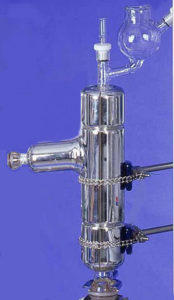Lab-scale Crude Oil Distillation
Distillation of crude oil in the laboratory models what happens in the refinery. The results of the lab-scale distillation predicts the quantity and quality of each distilled product from the refinery. This information is used to choose the best crude oils for a refinery at the best price.
The refinery distills crude oil in two stages. The first stage distills from the crude oil’s initial boiling point up to 370 °C. Different fractions are collected such as naphtha, jet fuel, and gas oil.
The residue from the atmospheric distillation is transferred to a vacuum pot still where it is distilled into fractions up to 565 °C.
True Boiling Point Distillation (TBP) – D2892
 Packed columns are used to model the atmospheric distillation unit in the refinery. This is often called “true boiling point” (TBP) distillation. The American Society for Testing and Materials (ASTM) has developed the standardized test method D2892 for this purpose.
Packed columns are used to model the atmospheric distillation unit in the refinery. This is often called “true boiling point” (TBP) distillation. The American Society for Testing and Materials (ASTM) has developed the standardized test method D2892 for this purpose.
The first stage of the packed column distillation distills from the initial boiling point up to about 200 °C vapor temperature at atmospheric pressure.
The second stage distills from approximately 200 °C up to 300 °C, atmospheric equivalent vapor temperature at 100 mmHg vacuum.
The final stage covers the range for 300 °C up to 370 °C at 10 mmHg vacuum.
During each stage the various distilled fractions (i.e. naphtha, jet fuel, gas oil) are collected and quantified. Each fraction is tested for a range of physical properties such as density, viscosity, sulfur content, flash point and so on.
Vacuum Pot Still (VPS) – D5236

The lab-scale distillation system used to model the vacuum distillation unit in the refinery is often called a vacuum pot still or VPS. D5236 is the ASTM test number.
Residue from the D2892 crude oil distillation is charged to the boiling flask of the vacuum pot still. The distillation covers the range of 370 °C up to 565 °C at a vacuum of 1 mmHg down to 0.1 mmHg vacuum.
Various fractions are collected during the VPS distillation. Physical and chemical properties testing is performed on these fractions.
Comments are closed, but trackbacks and pingbacks are open.